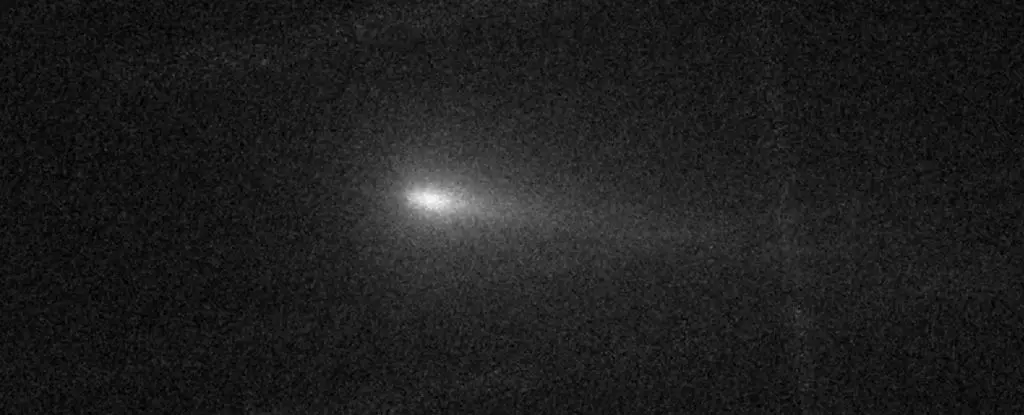Comets have long captivated humanity’s imagination, offering a glimpse into the ancient history of our solar system. These transitory visitors, often described as “dirty snowballs” of ice and dust, can bring excitement whenever they approach the Sun. One such comet, C/2024 S1, was anticipated to be particularly bright in the skies this October, potentially visible to the naked eye during Halloween festivities. However, recent observations indicate that this cosmic traveler is disintegrating just as it begins its celestial journey toward the Sun.
Discovered on September 27, C/2024 S1 is categorized as a Kreutz sungrazer comet. This classification indicates that its path will take it within a mere 1.2 million kilometers (approximately 750,000 miles) of our Sun on October 28, 2024. Initially, experts were optimistic that the comet would reach an extraordinary brightness, possibly outshining Venus and even becoming visible during daylight. Enthusiasts eagerly anticipated its arrival, hoping to witness a spectacular show in the night sky.
Sadly, however, it seems that nature had other plans. Observations throughout October revealed a curious sequence: the comet initially brightened due to outburst activity, only to later fade, with its nucleus seemingly vanishing from view. Images taken during this period depict a comet transitioning from a potentially bright spectacle to a mystery cloud of dust and debris, leaving both enthusiasts and astronomers in a state of disappointment at what might have been.
The disintegration of C/2024 S1 is not an unprecedented phenomenon. Many comets experience instability as they approach the intense heat of the Sun, leading to similar events. The comet underwent at least one significant outburst. Such outbursts manifest as sudden emissions of gas and dust. While they can temporarily brighten a comet, they may also signal fragility, hinting that the comet’s nucleus could be fragmenting. This instability is often due to the comet’s icy constitution—the volatile materials can transition from solid to gas in a process known as sublimation, which can accelerate the object’s rotation.
Historically, the phenomenon has been documented in spectacular fashion. In 2020, Comet C/2019 Y4 was observed breaking apart as it neared the Sun, providing powerful evidence of this disintegration process. The recent observations of C/2024 S1 similarly suggest that it may be rapidly fragmenting as it approaches its perihelion.
On October 9, a post on the Astronomer’s Telegram indicated that changes observed in C/2024 S1’s appearance likely signaled disintegration. Further photographs taken on October 20 and 22 by Czech amateur astronomer Martin Mašek revealed a continued decline in brightness, with the comet’s nucleus increasingly obscured. It is worth noting that even if the nucleus disintegrates entirely, the comet’s tail—formed from escaping dust and gas—might still remain visible for a time.
Despite the potential loss of its bright nucleus, some speculate that a larger fragment could survive the disintegration process and carry on toward the Sun. If so, observers might still catch a glimpse of this notable comet, although perhaps without the brilliant nucleus once anticipated.
Interestingly, C/2024 S1 isn’t alone in this cosmic lineage. It is theorized to be a remnant of a larger comet that broke apart centuries ago. The Kreutz sungrazers, including this one, are thought to originate from the Great Comet of 1106 CE, an event that dazzled observers of its time. As the remains of that magnificent comet, C/2024 S1 and its siblings provide scientists and astronomers with insights into the durability of these celestial bodies and the processes they undergo.
Currently, C/2024 S1 is best positioned for observation in the Southern Hemisphere using binoculars or small telescopes. Should a fragment persist after perihelion, enthusiasts in the Northern Hemisphere may yet have a second chance for a glimpse, albeit possibly without the spectacular head that was once expected.
The fate of C/2024 S1 remains uncertain as it approaches the Sun. Will it continue its journey, or will it vanish, leaving behind a faint trace of its existence in the form of a long, curved tail? This enigmatic narrative serves as a reminder of the unpredictability of the cosmos. As astronomers and skywatchers alike await further developments, the mystery of C/2024 S1 adds another layer to the ever-evolving story of our universe. In the meantime, enthusiasts are encouraged to remain vigilant, for even the most disheartened comets can bring unexpected surprises from the depths of space. Happy hunting!


Leave a Reply